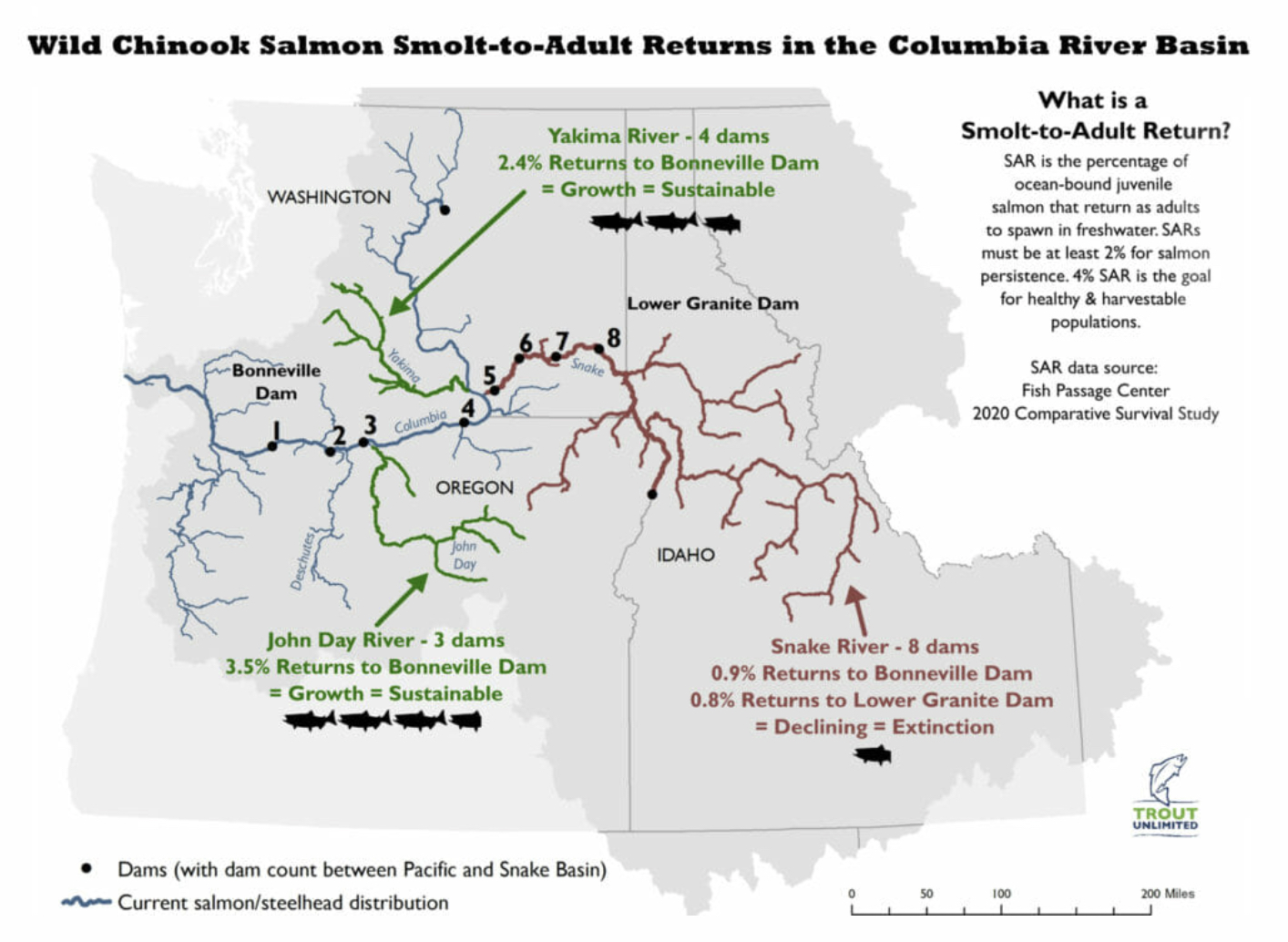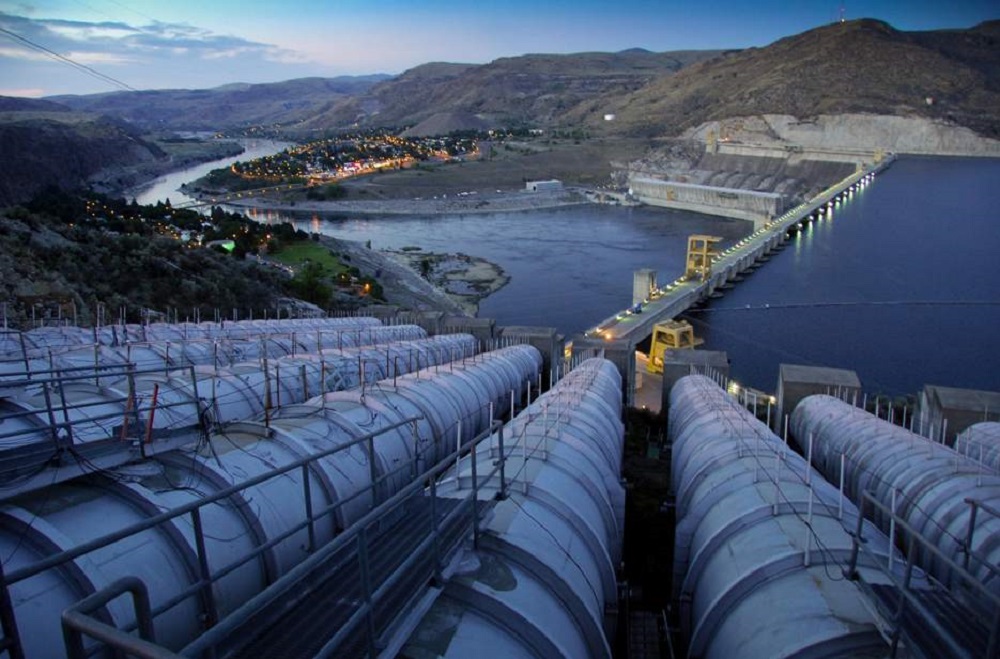An agreement among the U.S. Government, Washington, Oregon and four Native American tribes will facilitate the buildout of at least 1 GW to 3 GW of tribally sponsored clean energy capacity, the Biden Administration said.
Federal funding potentially reaching more than $1 billion will support the agreement, which began as a proposal to the Biden Administration from the four tribes and two states. The agreement encompasses the original proposal, known as the Columbia Basin Restoration Initiative, and has the ultimate goal of restoring salmon, steelhead and other native fish populations in the river basin.
A key feature of the agreement is the goal of breaching four dams on the lower Snake River, whose locations, all in southeast Washington, are shown in the image below from Trout Unlimited with the labels 5, 6, 7 and 8.

Salmon populations in the river system have been dwindling due to the presence of hydroelectric dams, the National Oceanic and Atmospheric Administration has reported. Salmon and steelhead populations on the lower Snake River are listed as threatened under the Endangered Species Act.
A 2022 report sponsored by Washington Governor Jay Inslee and U.S. Senator Patty Murray from Washington recommended that the services of the dams on the lower Snake River be replaced before any dams were breached.
The new agreement is aligned with that recommendation. It specifies actions by the parties to deploy renewable generation that would serve as replacement power for the lower Snake River hydroelectric dams, to pave the way for an authorization by Congress to breach the dams.
Under the agreement, the U.S. Departments of Energy and Agriculture will work with the signatory tribes to provide technical assistance, planning and funding for whatever role tribes want to take with regards to renewables projects, such as “individual or collective ownership, leasing, power procurement, etc.”
The four tribal nations that signed the agreement are the Confederated Tribes and Bands of the Yakama Nation, the Confederated Tribes of the Umatilla Indian Reservation, the Confederated Tribes of the Warm Springs Reservation of Oregon, and the Nez Perce Tribe. Dates of their treaties with the U.S. Government are shown below.

The U.S. Department of Energy will also provide funding to the Pacific Northwest National Laboratory and potentially other DOE labs to complete a regional energy needs planning process.
DOE said it would work with the Bonneville Power Administration, a federal agency that operates the region’s transmission, to “continue to advance reforms to BPA’s interconnection processes, aiming to significantly speed the interconnection process and identify means for more efficient use of existing transmission.”
Chairman Shannon F. Wheeler of the Nez Perce Tribe said in a statement “As Nimiipuu (Nez Perce) we are bound to the salmon and the rivers – these are our life sources. We will not allow extinction to be an option for the salmon, nor for us. The United States is bound to salmon and to us by Treaty where we reserved all our fisheries – our Treaty is the supreme law of the land under the United States Constitution.”
The recommendations issued by Governor Inslee and Senator Murray in 2022 called for immediate action to deploy the scale of clean energy infrastructure necessary to confront the climate crisis, regardless of whether Congress authorizes the breaching of the lower Snake River dams.
Several of the parties signing the agreement are parties to pending lawsuits to protect native fish populations in the Columbia River Basin, who agreed to put their lawsuits on hold in favor of pursuing the agreement.
Regarding the planned replacement of hydropower with renewables, Nancy Hirsh, executive director of the NW Energy Coalition, said that in the past decade the region has replaced 2 GW of coal generation with new wind, solar, battery storage and energy efficiency. She highlighted a 2022 study by the consultancy Energy Strategies that her group sponsored, which found that building 1.3 GW of solar, 1.4 GW of wind and 0.2 GW of battery capacity would be the least-cost option for replacing the four dams’ annual generation in a way that would balance the region’s substantial remaining hydropower generation.
The Bonneville Power Administration estimated that the agreement will have an annual average rate impact of 0.7%.
Hirsh said “no one is saying these replacement energy services are free, but the cost of maintaining the lower Snake River dams is substantial and managing salmon to extinction is unacceptable.”
The 92-page agreement among the tribes, states and the U.S. Government was filed in the Federal District Court in Oregon, and is available in three parts: the memorandum of understanding, the Columbia Basin Restoration Initiative, and the federal government’s commitments.
This content is protected by copyright and may not be reused. If you want to cooperate with us and would like to reuse some of our content, please contact: editors@pv-magazine.com.








By submitting this form you agree to pv magazine using your data for the purposes of publishing your comment.
Your personal data will only be disclosed or otherwise transmitted to third parties for the purposes of spam filtering or if this is necessary for technical maintenance of the website. Any other transfer to third parties will not take place unless this is justified on the basis of applicable data protection regulations or if pv magazine is legally obliged to do so.
You may revoke this consent at any time with effect for the future, in which case your personal data will be deleted immediately. Otherwise, your data will be deleted if pv magazine has processed your request or the purpose of data storage is fulfilled.
Further information on data privacy can be found in our Data Protection Policy.